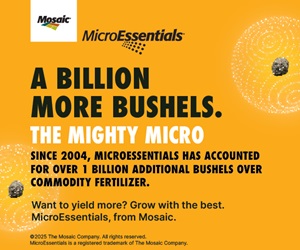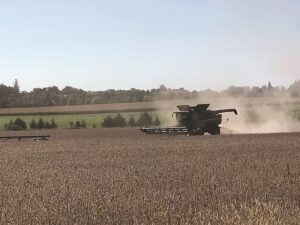Strip tillage research
MAXIMIZING THE USE OF NUTRIENTS AND REDUCING SOIL LOSS

AS STRIP TILLAGE HAS BEEN investigated and promoted in Ontario during the last 20 years, its use has grown slowly but steadily because it can achieve a variety of aims. For example, it can lead to better fertilizer use, reduce nutrient runoff, and boost yield.
WHAT YOU NEED TO KNOW
- Growers have increasingly adopted strip tillage over the past 20 years.
- The benefits of strip tillage include better fertilizer use, reduced nutrient runoff, and boosted yields.
- Ben Rosser, corn specialist at the Ontario Ministry of Agriculture, Food and Rural Affairs, has been conducting Grain Farmers of Ontario-sponsored research on yield improvements using strip tillage.
- Rosser and his team found that yields of spring strip-till and P and K were significantly higher (4.1 bushels/acre) than where P and K were broadcast and incorporated with full-width tillage.
- Conservation tillage and fertilizer placement combination can not only reduce costs ($10-37/acre savings for tillage and fertilizer application costs versus full-width tillage based on Ontario custom rates survey) but can also provide greater yields and income ($20/acre at $5.00/bushel corn).
“A few years ago, we started looking at the yields that could be achieved with strip-till and sub-surface placement of fertilizer,” says Ben Rosser, corn specialist with the Ontario Ministry of Agriculture, Food and Rural Affairs. “In other jurisdictions like Ohio, they’ve noticed particulate phosphorus (P) losses have been lowered through soil conservation efforts like reduced tillage, but dissolved P losses were increasing where fertilizer was left on the soil surface in reduced tillage systems. Strip-till with subsurface placement of fertilizer could potentially address both issues.”
Agronomist Aaron Breimer, general manager at Elite Agri Solutions, notes that because P does not readily move through the soil and the vast majority of uptake happens through roots directly intercepting it, subsurface placement of P is a good idea. “The advent of strip tillage and autosteer has boosted the ability to utilize this approach, placing P where it’s going to benefit the crop the most,” he says.
Breimer adds that a benefit of strip tillage is that the macropores suspected of causing the movement of dissolved P into tiles and out into surface water (ditches, rivers and lakes) — are disrupted and broken up, similar to conventional tillage, but between the strips the macropores are left intact. “This allows for natural drainage to still occur,” he notes, “which is important particularly when there are heavy rainfall events to prevent surface runoff.”
Over three recent growing seasons, Rosser led a study evaluating the ability of strip tillage-applied fertilizer to replace surface broadcast and incorporated applications of P and potassium (K) fertilizer in lower-fertility soils and comparing yield responses to that seen with more traditional tillage and broadcast P and K applications. The trials followed soybeans or cereals and were built on previous similar research supported by Grain Farmers of Ontario conducted in different areas of the province.
STRIP-TILL IN SPRING
Jumping right into results, Rosser and his team found that yields of spring strip-till and P and K were significantly higher (4.1 bushels/acre) than where P and K were broadcast and incorporated with full-width tillage.
“It’s clear that on low-fertility soils that can be successfully strip-tilled in the spring (that is, you have well-drained medium-to-lighter soil textures), spring strip-till with fertility provides a yield advantage over broadcast incorporated fertilizer,” says Rosser. “This demonstrates that this conservation tillage and fertilizer placement combination can not only reduce costs ($10-37/acre savings for tillage and fertilizer application costs versus full-width tillage based on Ontario custom rates survey) but can also provide greater yields and income ($20/acre at $5.00/bushel corn). While treatments cannot prove whether this is strictly tillage or fertility-related, fertilizer placement on low-testing soils is expected to be a strong driver.” Rosser adds that this conclusion would be especially important when a grower is not expected to build soil fertility.
Rosser also reports that despite the logistical benefits of doing strip-till in the late summer or fall, many growers on well-drained soils have already moved to spring strip-till and fertilizer. “From strictly a yield perspective, it makes sense to do so, according to our data,” he says. “I think having the equipment, labour and logistics (fertilizer) in place to have both strip-tiller and planter running in spring helps them get that done. It’s not totally unlike what is needed for conventional tillage operations where secondary tillage and planting are all done in spring.”
STARTING WITH STARTER
Rosser found in the study that yields of spring strip-till and P and K were significantly higher (4.7 bushels/acre) than fall strip-till and P and K. He stresses, however, that if you have soils you are not comfortable strip-tilling in the spring (medium or lighter texture, good drainage), this difference in yield can be made up by including starter fertilizer on fall strips. In the treatments tested, the same total amount of fertilizer was applied, just at different times, so the total investment in fertilizer is the same.
Breimer is cautious about spring strip-tilling or even freshening of the spring strips. “Perhaps on lighter soil, it is an approach that works, but my experience on medium and heavier soil types is that fall strip tillage is best followed by stale seedbed planting the following spring directly into the strips,” he says.
In Rosser’s view, some growers will prefer to strip-till in the fall or spring and will also consider the value of starter fertilizer on their corn planter. “You have to look at whether the planter already has starter fertilizer capabilities or does this need to be added,” he explains. “And you have to look at what the expected benefit to starter fertilizer (soil test levels, etc.) will be — what are the logistical costs of running starter fertilizer relative to their perceived benefits?”
On the subject of starter, Rosser’s common question is whether strip fertilizer can replace the need for it on the corn planter. From his study, he can say that moving a portion of fertilizer from fall strips to spring starter might be a slight yield benefit.
“Growers would have to decide if the value of this practice ($16/acre at $5.00/bushel corn) covers the costs of investing in 2×2-inch starter fertilizer equipment if your planter is not already equipped and tendering starter fertilizer to the planter in the spring,” he says. “In our study, applying starter fertilizer on fall-fertilized strips did narrow the yield gap between fall and spring strip-till — spring strip and fertility was not significantly higher- yielding than where fertilizer was split between fall strip and planter starter.”
Reflecting on corn prices, Rosser notes that over the last year, they’ve been higher than $5 (though now trending down), so that would make splitting potentially more attractive than the cost-benefit analysis noted earlier. However, if a fertilizer placement and delivery system has to be purchased, growers have to factor in the current increased equipment prices into their decisions.
Looking forward, Rosser says there are still a lot of questions on the strip-till fertility front, particularly how to safely apply larger amounts of fertilizer where crop injury could be a concern. He is currently working on a Grain Farmers of Ontario-funded project with Dr. John Lauzon at the University of Guelph, investigating crop safety and response for various fertilizer placements in-strip.
This project is funded in part by the Canadian Agriculture Partnership (CAP), a five-year investment by Canada’s federal, provincial, and territorial governments. •



















